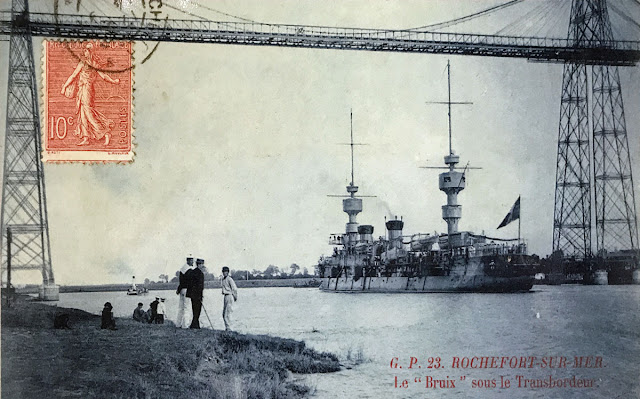After two months in Croatia following the start of the season in Southern Brittany and having dropped Belisama in Rochefort for the summer, I made it back to Rochefort to prepare for the conveying of Belisama to the Mediterranean. Rochefort is a place to be visited by any sailor as it used to be the centre of sailing activities for centuries in France. And it shows in the city!
This painting is located in the Corderie of Rochefort, but was it painted by a sailor?
I could not figure out where the wind is supposed to be coming in relation with the position of the sails on the various boats...
The first discovery when boarding back on Belisama was an explosion of Lilla Belisama, our dinghy, probably in relation with a very hot summer that increased the air pressure inside and melted the glue used for its assembly. Given the extent of the wound, I strongly considered replacing it. However, a quick intensive research through the ship chandlers around indicated that they do not keep in stock 3m dinghies and that therefore, it would take a week at least to have it delivered. I then decided to glue it back, and it worker perfectly!
The visit to the Rochefort "corderie" was fascinating. First the building size! The basic unit in the French navy at the time, for ropes, was the "encablure" or "cable length", the length of which varied among the fleets at the time, but was pretty much 1/10th of a nautical mile, therefore around 180 to 200 metres in length. This explains the 300 metre length of the Royal Corderie in Rochefort! In order to get a final rope of 200 metres, 300 metres of hemp thread should be prepared before being weaved, which would result in 30% reduction in length, explaining the 300 metre building to produce 200 metre ship ropes. By the way any war ship at this time was embarking up to 80 tonnes of ropes on board, explaining the very strategic nature of rope production.
Of interest as well is the "transbordeur", an interesting way to cross the Charente river south of Rochefort. Being located a few miles from the sea, in the Charente river, Rochefort was considered a very safe place. But because of its strategic interest in ship building, the air clearance on the river needed to remain very high to allow for the biggest ships to be able to reach and get out from Rochefort. Therefore, at the end of the XIX century, it was decided to construct a way to cross the Charente river downstream from Rochefort with an air clearance of 50 metres. No option for a normal bridge could be considered given these constraints!
Then a "transbordeur" was considered, which is basically a portion of road hung under cables supported by high poles and that moves from one side to the other of the river, therefore ensuring the continuity of the road.
The coffee shop at the base of the cables for the transbordeur.
The engineer who conceived the transbordeur is not Gustave Eiffel, as one would think looking at the structure of the pillars. The transbordeur was conceived in 1887 by Ferdinand Joseph Anodin, born in 1845. The "suspended bridge" was constructed from 1898 to 1900, in 27 months. The bridge deck is 50 metres above the water level. The bridge was inaugurated on 29 July 1900. The arrangement of the cables holding the platform are very sophisticated to prevent any possibility lof motion in any direction, regardless of the strength of the winds.
The moving road section hung under the metal frame construction
In 1966, the transbordeur bridge is the setting for the Jacques Demy famous film, Les demoiselles de Rochefort. In February 1967, the bridge makes is last official crossing of the Charente river.
Patrick Deludin © Archives Municipales de Rochefort
The transbordeur bridge remains an iconic star in the area as you can see on the logo of the local Leclerc shopping centre.
Finally, on Saturday 3rd September, we set at sea from Rochefort for A Coruña, a 370 nautical mile ride through the Gulf of Biscaye.
Passing the fishing cabanes downstream on the Charente river
So, when will we make it... ?












No comments:
Post a Comment